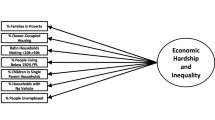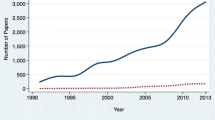Abstract
A growing body of research has explored the impact of neighborhood residence on child and adolescent health and well-being. Most previous research has used the US Census variables as the measures of neighborhood ecology, although informative census data are not designed to represent the sociological and structural features that characterize neighborhoods. Alternatively, this study explored the use of large-city administrative data and geographical information systems to develop more uniquely informative empirical dimensions of neighborhood context. Exploratory and confirmatory structural analyses of geographically referenced administrative data aggregated to the census-block group identified three latent dimensions: social stress, structural decline, and neighborhood crime. Resultant dimensions were compared through canonical regression to those derived from US Census data. The relative explanatory capacity of the city-archival and census dimensions was assessed through multilevel linear modeling to predict standardized reading and mathematics achievement of 31,742 fifth- and 28,922 eight-grade children. Results indicated that the city-archival dimensions uniquely augmented predictions, and the combination of city and census dimensions explained significantly more neighborhood effects on achievement than did either source of neighborhood information independently.
Similar content being viewed by others
Notes
Wilks’s lambda is used to test the significance of the first canonical correlation. If p < .05, the two sets of variables are significantly associated by canonical correlation.
Rc represents the canonical correlation, which is a form of correlation relating two sets of variables. Canonical correlations are interpreted the same as Pearson’s r; their square is the percent of variance in the canonical variate of one set of variables explained by the canonical variate for the other set along the dimension represented by the given canonical correlation.
References
Ellen IG, Mijanovich T, Diliiman KN. Neighborhood effects on health: exploring the links and assessing the evidence. J Urban Aff. 2001; 23(3):391–408.
Sampson RJ, Morenoff J, Gannon-Rowley T. Assessing “neighborhood effects”: social processes and new directions in research. Annu Rev Sociology. 2002;28:443–478.
Caughy MO, O’Campo PJ, Patterson J. A brief observational measure for urban neighborhoods. Health Place. 2001;7(3):225–236.
Raudenbush SW, Sampson RJ. Ecometrics: toward a science of assessing ecological settings, with application to the systematic social observation of neighborhoods. Sociol Method. 1999;29(1):1–41.
Mujahid MS, Diez Roux AV, Morenoff JD, Raghunathan T. Assessing the measurement properties of neighborhood scales: from psychometrics to ecometrics. Am J Epidemiol. 2007;165(8):858–867.
Chow J, Coulton C. Was there a social transformation of urban neighborhoods in the 1980s? A decade of worsening social conditions in Cleveland, Ohio, USA. Urban Stud. 1998;35(8):1359–1375.
Rajaratnam JK, Burke JG, O’Campo P. Maternal and child health and neighborhood context: the selection and construction of area level variables. Health Place. 2005;12(4):547–556.
Jencks C, Mayer S. The social consequences of growing up in a poor neighborhood. In: Lynn LE, McGeary MFH, eds. Inner-city Poverty in the United States. Washington, D.C.: National Academy; 1990:111–186.
U.S. Census Bureau. Census 2000 Data Engine CD-ROM [CD-ROM]. Orange: SRC, LLC; 2000.
Duncan GJ, Raudenbush SW. Getting context right in quantitative studies of child development. In: Thornton A, ed. The Well-Being of Children and Families: Research and Data Needs. Ann Arbor: University of Michigan Press; 2001:356–383.
Hogan JW, Tchernis R. Bayesian factor analysis for spatially correlated data with application to summarizing area-level material deprivation from census data. J Am Stat Assoc. 2004;99(466):314–324.
Sampson RJ, Morenoff JD, Earls F. Beyond social capital: spatial dynamics of collective efficacy for children. Am Sociol Rev. 1999;64:633–660.
Spencer MB, McDermott PA, Burton LM, Kochman TJ. An alternative approach to assessing neighborhood effects on early adolescent achievement and problem behavior. In: Brooks-Gunn J, Duncan GJ, Aber JL, eds. Neighborhood Poverty: Vol. 2. Policy Implications in Studying Neighborhoods. New York: Sage; 1997:145–163.
Viring BA, McBean M. Administrative data for public health surveillance and planning. Annu Rev Public Health. 2001;22:213–230.
Burton LM, Price-Spratlen T, Spencer MB. On ways of thinking about measuring neighborhoods: implications for studying context and developmental outcomes for children. In: Brooks-Gunn J, Duncan GJ, Aber JL, eds. Neighborhood Poverty: Vol. 2. Policy Implications in Studying Neighborhoods. New York: Russell Sage Foundation; 1997:23–47.
Goodman AC. A comparison of block group and census tract data in a hedonic housing price model. Land Econ. 1977;53(4):483–487.
Pennsylvania Department of Education. Assessment. Available at: http://www.pde.state.pa.us/a_and_t/site/default.asp. Accessed on: November 10, 2006.
U.S. Department of Education. No Child Left Behind, Accountability and Adequate Yearly Progress (AYP). Presented at the National Title I Directors’ Conference. Available at: http://www.ed.gov/admins/lead/account/ayp203/edlite-index.html. Accessed on: November 17, 2006.
Thacker AA, Dickinson ER. Item Content and Difficulty Mapping by Form and Item Type for the 2001–03 Pennsylvania System of School Assessment (PSSA). Alexandria: HumRRO; 2004.
Thacker AA, Dickinson ER, Koger ME. Relationships among the Pennsylvania System of School Assessment (PSSA) and Other Commonly Administered Assessments. Alexandria: HumRRO; 2004.
Snook SC, Gorsuch RL. Component analysis versus common factor analysis: a Monte Carlo study. Psychol Bull. 1989;106(1):148–154.
Cattell RB. The scree test for the number of factors. Multivariate Behav Res. 1966;1(2):245–276.
Velicer WF. Determining the number of components from the matrix of partial correlations. Psychometrika. 1976;31(3):321–327.
Buja A, Eyuboglu N. Remarks on parallel analysis. Multivariate Behav Res. 1992;27(4):509–540.
Geweke JF, Singleton KI. Interpreting the likelihood of ratio statistic in factor models when sample size is small. J Am Stat Assoc. 1980;75(369):133–137.
Fabrigar LR, Wegener DT, MacCallum RC, Strahan EJ. Evaluating the use of exploratory factor analysis in psychological research. Psychol Methods. 1999;4(3):272–299.
Yates A. Multivariate Exploratory Data Analysis: a Perspective on Exploratory Factor Analysis. Albany: State University of New York Press; 1987.
Wood JM, Tataryn DJ, Gorsuch RL. Effects of under- and overextraction on principal axis factor analysis with varimax rotation. Psychol Methods. 1996;1:354–365.
Anderberg MR. Cluster Analysis for Applications. New York: Academic; 1973.
Harman HH. Modern Factor Analysis. 3rd edn. Chicago: University of Chicago Press; 1976.
Brown TA. Confirmatory Factor Analysis for Applied Research. New York: Guilford; 2006.
Hu L, Bentler PM. Cutoff criteria for fit indexes in covariance structure analysis: conventional criteria versus new alternatives. Struct Equ Modeling. 1999;6(1):1–55.
Guadagnoli E, Velicer W. A comparison of pattern matching indices. Multivariate Behav Res. 1991;26(2):323–343.
Miller JK, Farr SD. Bimultivariate redundancy: a comprehensive measure of interbattery relationship. Multivariate Behav Res. 1971;6(3):313–324.
Van den Wollenberg AL. Redundancy analysis—an alternative to canonical correlation analysis. Psychometrika. 1977;42(2):207–219.
Landis JR, Koch GG. An application of hierarchical Kappa-type statistics in the assessment of majority agreement multiple observers. Biometrics. 1977;22(2):363–374.
Raudenbush SW, Bryk AS. Hierarchical Linear Models: applications and Data Analysis Methods. 2nd edn. Thousand Oaks: Sage; 2002.
Burnham KP, Anderson DR. Multimodel response: understanding AIC and BIC in model selection. Sociol Methods Res. 2004;33(2):261–304.
Massey D, Denton N. Suburbanization and segregation in U.S. metropolitan areas. Am J Sociol. 1988;94(3):592–626.
Crano WD, Kenny DA, Campbell DT. Does intelligence cause achievement? J Educ Psychol. 1972;63(3):671–684.
Coulton CJ, Korbin JE, Su M. Measuring neighborhood context for young children in an urban area. Am J Community Psychol. 1996;24(1):5–32.
Haney TJ. “Broken windows” and self-esteem: subjective understanding of neighborhood poverty and disorder. Soc Sci Res. 2007;36(3):968–994.
Aneshensel CS, Sucoff CA. The neighborhood context of adolescent mental health. J Health Soc Behav. 1996;37:293–310.
Cohen DA, Mason K, Bedimo A, Scribner R, Basolo V, Farley TA. Neighborhood physical conditions and health. Am J Public Health. 2003;93(3):467–471.
Hill TD, Ross CE, Angel RJ. Neighborhood disorder, psychophysiological distress, and health. J Health Soc Behav. 2005;46(2):170–186.
Furstenberg FF. How families manage risk and opportunity in dangerous neighborhoods. In: Wilson WJ, ed. Sociology and the Public Agenda. Newbury Park: Sage; 1993:231–258.
Leventhal T, Brooks-Gunn J. Moving to opportunity: an experimental study of neighborhood effects on mental health. Am J Public Health. 2003;93(9):1576–1582.
Linares LO, Heeren T, Bronfman E, Zuckerman B, Augustyn M, Tronick E. A meditational model for the impact of exposure to community violence on early child behavior problems. Child Dev. 2001;72(2):639–652.
Garbarino J, Bradshaw CP, Vorrasi JA. Mitigating the effects of gun violence on children and youth. Future Child. 2002;12:73–85.
Bowen NK, Bowen GL. Effects of crime and violence in neighborhoods and schools on the school behavior and performance of adolescents. J Adolesc Res. 1999;14(3):319–342.
Wolter KM. Some coverage error models for census data. J Am Stat Assoc. 1986;81(394):338–346.
Lloyd CD. Local Models for Spatial Analysis. Boca Raton: CRC/Taylor & Francis; 2006.
Acknowledgment
This research was conducted with cooperation from the Kids Integrated Data System of the City of Philadelphia, PA, USA, in conjunction with the Cartographic Modeling Laboratory, University of Pennsylvania, Philadelphia, PA, USA.
Author information
Authors and Affiliations
Corresponding author
Rights and permissions
About this article
Cite this article
Gross, K.S., McDermott, P.A. Use of City-Archival Data to Inform Dimensional Structure of Neighborhoods. J Urban Health 86, 161–182 (2009). https://doi.org/10.1007/s11524-008-9322-7
Received:
Accepted:
Published:
Issue Date:
DOI: https://doi.org/10.1007/s11524-008-9322-7




